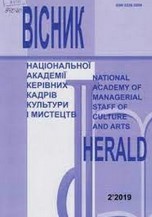ІСТОРИЧНИЙ РАКУРС ФУНКЦІОНУВАННЯ СИСТЕМИ АМПЛУА В ПРОЦЕСІ СТВОРЕННЯ АКТОРОМ ХУДОЖНЬОГО ОБРАЗУ РОЛІ
HISTORICAL PERSPECTIVE OF ROLE SYSTEM FUNCTIONING IN THE PROCESS OF ACTOR’S ROLE IMAGE CREATION
Author(s): Natalia Petrivna DonchenkoSubject(s): Theatre, Dance, Performing Arts, History of Art
Published by: Національна академія керівних кадрів культури і мистецтв
Keywords: actor; theatre; role;
Summary/Abstract: The purpose of the article is to highlight and characterise the artistic and aesthetic expediency of the role as a way of an actor’s existence in a dramatic theatre in the image of a role in different historical periods. The research methodology consists in using the functional method to determine the cognitive-semantic category of the role in the performer's skill, their pragmatic characteristics as a principle of organising the effectiveness of the actor's artistic creativity over the role. The art history method has been applied to analyse the ideological and aesthetic value of the role method in reproducing the character’s image in a dramatic form. The comparative method enabled the conducting of the comparative analysis of the role performance in the actor’s work and its classification reference by certain criteria. The axiomatic method has been used to generalise the well-established ideas of the creative expediency of using a role in the process of role creating and its artistic value. The cultural and historical method made it possible to understand the criteria of artistry in the performing activity of role masters in different historical periods. The novelty of the research consists in a comprehensive analysis of the role as a way of an actor’s existence in a role, their effectiveness, efficiency, and aesthetic value in the performer’s stage activity of a certain role material. Conclusions. With the advent of reformatory directing, the theatrical art underwent global changes in the structuring of the actor's creative workshop, expanding their range of artistic performance. That artistic performance was specifically aimed at developing the performer’s individuality as a whole, their internal and external technique of stage creativity, and not at emphasising artistry on the actor’s external natural data, which were previously predicted lineage. And this prompted the shifting of the role category as the value of art to the background and approved the artistic playing function as a large-scale performance expression. The role as a way of an actor’s existence in a role loses its centuries-old theatrical practice, but does not leave some types of stage for contemporary theatrical art.
Journal: Вісник Національної академії керівних кадрів культури і мистецтв
- Issue Year: 2022
- Issue No: 4
- Page Range: 150-155
- Page Count: 6
- Language: Ukrainian

